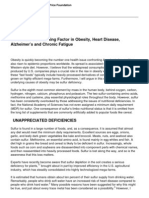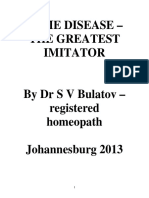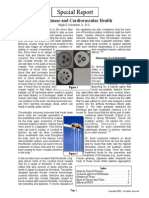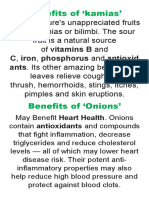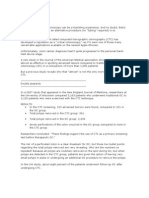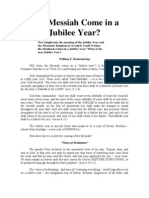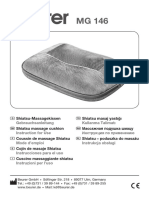Mold Toxins
Mold Toxins
Uploaded by
Condor7tCopyright:
Available Formats
Mold Toxins
Mold Toxins
Uploaded by
Condor7tOriginal Description:
Copyright
Available Formats
Share this document
Did you find this document useful?
Is this content inappropriate?
Copyright:
Available Formats
Mold Toxins
Mold Toxins
Uploaded by
Condor7tCopyright:
Available Formats
MOLD AND LYME TOXINS Richard Loyd, Ph.D.
Mold toxins are found in foods such as grains and peanuts. Far more serious are the mold toxins found in buildings with water leaks. Buildings with flat roofs and buildings on a concrete slab at the bottom of a hill are ready-made for mold problems. Mold toxins are the most common of the biotoxins and are responsible for many of the symptoms of many Lyme disease patients. When a building has a water leak or water damage that is not immediately corrected, molds such as Stachybotrys, Aspergillus, Acremonium, Actiniomycetes, Penicillium and Chaetomium are likely to start colonies. The colonies may be visible or they may be hidden in places such as the tops of ceiling tiles or the bottoms of carpets. (What, you still have carpets?) The molds send out spores which contain powerful biotoxins that are nerve toxins or neurotoxins. When these spores with their neurotoxins are inhaled, about 75% of the population can make antibodies to the toxins and quickly eliminate them. They may sneeze, have a sore throat or have other minor symptoms, but symptoms are temporary. If they spend several days in a moldy building, they may begin to feel sick, but when they are away for a few days they recover. About 25% of the population have a genetic makeup that makes them unable to produce the needed antibodies for mold toxins. The body simply does not adequately tag the toxins as invaders and it does not eliminate them. The liver can send them to the digestive tract via the bile, but they are quickly reabsorbed back into the blood. The result is that continual or repeated exposures to mold toxins result in an ever increasing amount of these toxins in the body. Those who can actually smell musty odors where they live or work usually have the worst mold toxin problems. It is estimated that 10 million American children are being exposed to mold toxins (many are medicated with Ritalin as a result) and around 25 million Americans have some degree of mold toxin illness. It is also common to have a genetic makeup that does not detoxify Lyme toxins and many cannot detoxify either mold or Lyme toxins. If they have Lyme disease, Lyme toxins also build up in the body. These are the people that get very sick and stay sick when they do frequency treatments for Lyme. FOR THOSE WHO GET MAJOR PROLONGED DIEOFF REACTIONS, FREQUENCY TREATMENTS FOR LYME ARE NOT RECOMMENDED UNTIL THE TOXIN ISSUE IS ADDRESSED. These mold and Lyme toxins attach to fat cells and cause the fat cells to continually release inflammatory cytokines. The result is chronic inflammation with symptoms such as fatigue, pain, brain fog, out of control weight gain and loss of sex drive. When a person has the flu, symptoms are not caused directly by the viruses. The symptoms are caused by the resulting cytokines. So mold and Lyme toxins can cause symptoms similar to a permanent case of flu.
An inflammatory reaction is very useful to help deal with an infection. It is devastating when it goes on and on.
This chart from Abbas Qutab, M.D. illustrates what happens. The mold and Lyme toxins cause the fat cells to make a material called NF-kappaB. NF-kappaB causes all kinds of inflammatory chemicals to be released. And these chemicals can have great adverse effects if they are produced over a long period of time. You can see the listed results such as pain, inflammation, heart disease, blood sugar problems, autoimmune diseases, cancer and nerve damage. Another thing that happens is that some of these chemicals actually cause another increase in NF-kappaB! It is like when they turn a PA system up too high and the mike and speaker feedback and you get a very loud and unpleasant squeal. So the body can get stuck in a feedback loop where NF-kappaB increases inflammatory chemicals which increase NF-kappaB which increases inflammatory chemicals. Cytokines also cause the release of a material called MMP9 that makes people feel terrible.
Cytokines also cause reduced circulation in small blood vessels with greatly reduced oxygen and nutrients to the cells. This acts similarly to advanced heart disease and any exercise can result in a crash that lasts for days. Excess cytokines are also related to autoimmune problems. And autoimmune reactions are much more common in people with long arms "wingspan" longer than their height. Mold and Lyme toxin patients may make antibodies to myelin with resulting nerve damage. MS patients should be checked for mold and Lyme toxins. They may make antibodies to a material called cardiolipin. This causes blood to sludge. Hands and feet are often cold. More commonly they make antibodies to gliadin which is a protein found in gluten. The result is an inability to tolerate gluten grains (wheat, rye, oats, barley). A diet high in sugar and in the starch amylose (wheat, rye, oats barley, rice, root vegetables, bananas) causes rapid blood sugar and insulin spikes making things worse. Some materials like dopamine and serotonin cannot cross the blood brain barrier (BBB). But the BBB does not slow down inflammatory cytokines at all, so they enter the brain and block various receptor sites. When the leptin receptor sites are blocked, leptin levels increase and leptin resistance is produced. The excess leptin packs fat into fat cells where it stays until the toxins are removed. People with high leptin can gain weight on 1000 calories. When leptin receptors are blocked, the production of a chemical called MSH is blocked. If MSH is low, melatonin production will be low, resulting in sleep problems. If MSH is low, endorphins will be low resulting in excess chronic pain. MSH also controls pituitary hormone production and if MSH is low, there will be a loss of hormonal control. If cortisol is low, treatment should be to remove the neurotoxins. If cortisol is given, that depresses ACTH production and this can make the person's health much worse. Taking cortisol or steroid drugs while biotoxins levels are high can result in serious permanent injury. Low MSH can also result in low androgens in both men and women. If androgens are low, symptoms will be much worse. That appears to be why most chronic fatigue patients are women. Anti-diuretic hormone production by the pituitary is often disrupted resulting in excess urination even to the point of dehydration and excess thirst and excess salt remaining in the blood. There may also be a layer of salt on the skin. When that happens, the person is
a good conductor of electricity and many patients have problems with static electricity shocks. They may damage electronic equipment by touching it. People who are low in MSH often have leaky gut which lets in gliadin which causes more inflammation and further reduces MSH which causes more leaky gut which lets in more gliadin. In any case of bowel disease, mold and Lyme toxins should be checked. Eighty percent of low MSH patients have colonization in their sinuses by a variety of bacteria called "multiply antibiotic-resistant coagulase negative staph." (Yes, that is the correct spelling!) In most people, this organism is fairly benign, but in low MSH patients it must be taken care of before they can feel good. Colloidal silver nose drops are a possibility. Dr. Ritchie Shoemaker, M.D. puts his patients on a low amylose diet and uses Cholestyramine to remove the toxins. Cholestyramine causes bloating, digestive discomfort and constipation in most patients. We have experimented with plant sterols in the form of Cholestepure (2 X 3) with very good results and little or no negative effects. C-Food from Precision Herbs (4 X 3) also works well for biotoxin removal. Plan on taking one to two months for this. Stay away from moldy places and moldy foods. Dr. Shoemaker reports that about 1-2% of the population do not get adequate improvement just by reducing mold and Lyme toxins. Reducing Lyme toxins with Cholestyramine can even cause an increase of symptoms. In these cases he uses Actos to lower inflammatory cytokines, leptin and MMP9. On the other hand, Actos will make underweight (low leptin) patients worse. To reduce inflammation we have used a number of products such as Metagenics UltraInflamX, Kaprex, and Kaprex AI, and Biotics KappArrest. The supplements with "kap" in their names inhibit NF-kappaB. If you take another look at the NF-kappaB chart you will see why this is a good idea. Homeopathics for mold and Lyme could also help. If the molds are actually causing infection, Nano+ or Immune Yeast and Fungus can be used along with a good flora product and a toxin removal program. For much more detailed information, see the book "Mold Warriors" by Dr. Shoemaker.
You might also like
- Abram Hoffer - Prousky - Niacinamide's Potent Role in Alleviating Anxiety With Its Benzodiazepine-Like Properties - TextDocument8 pagesAbram Hoffer - Prousky - Niacinamide's Potent Role in Alleviating Anxiety With Its Benzodiazepine-Like Properties - TextEbook PDF100% (1)
- Detoxification ProtocolsDocument231 pagesDetoxification ProtocolsHanneke Thesame100% (7)
- How To Detox After A Vaccine Christiane Northrup, M.DDocument6 pagesHow To Detox After A Vaccine Christiane Northrup, M.Dvaluecare1542100% (1)
- Grades: - 3 Midterms (20%) Held in Lab - Final (15%) - Comprehensive - Labs (25%) - 94% Is An A - Powerpoints Online!Document3 pagesGrades: - 3 Midterms (20%) Held in Lab - Final (15%) - Comprehensive - Labs (25%) - 94% Is An A - Powerpoints Online!Keesha Mae Urgelles TimogNo ratings yet
- Billys Protocol For Curing Lyme DiseaseDocument3 pagesBillys Protocol For Curing Lyme Diseaseambertje12100% (1)
- HELP and How To Make Gcmaf Probiotic Yogurt Known As Maf 314Document8 pagesHELP and How To Make Gcmaf Probiotic Yogurt Known As Maf 314Anonymous LXV7PwpNo ratings yet
- Stress Management WorksheetDocument2 pagesStress Management WorksheetSabbir ThePsychoExpressNo ratings yet
- Reiki IIDocument39 pagesReiki IIAnonymous DqeRRe100% (2)
- CASA QuestionnaireDocument2 pagesCASA QuestionnaireRajesh KumawatNo ratings yet
- Mold Toxins Richard Loyd MDDocument4 pagesMold Toxins Richard Loyd MDOliver QueenNo ratings yet
- Naturally Reversed: The Ultimate Guide to Reversing ALL Dis-EaseFrom EverandNaturally Reversed: The Ultimate Guide to Reversing ALL Dis-EaseNo ratings yet
- The Sodium Bicarbonate Cancer Cure - Fraud or Miracle?: Sodium Bicarbonate in the Prevention and Treatment of All Sickness and DiseaseFrom EverandThe Sodium Bicarbonate Cancer Cure - Fraud or Miracle?: Sodium Bicarbonate in the Prevention and Treatment of All Sickness and DiseaseRating: 5 out of 5 stars5/5 (2)
- The Chelation Controversy: How to Safely Detoxify Your Body and Improve Your Health and Well-BeingFrom EverandThe Chelation Controversy: How to Safely Detoxify Your Body and Improve Your Health and Well-BeingRating: 5 out of 5 stars5/5 (1)
- Lugol and GraveDocument6 pagesLugol and GraveSeptiandry Ade Putra100% (2)
- Candida VulvovaginitisDocument20 pagesCandida VulvovaginitisVicobeingo100% (1)
- Health Psychology Assignment (MA201477)Document7 pagesHealth Psychology Assignment (MA201477)Syeda DaniaNo ratings yet
- MB 0457Document14 pagesMB 0457Isabel RosendoNo ratings yet
- Gcmaf Will Save 600,000 Lives From Cancer in American HopitalsDocument6 pagesGcmaf Will Save 600,000 Lives From Cancer in American HopitalsAmanda Trebiano100% (1)
- Adverse Effects of FluoroquinolonesDocument10 pagesAdverse Effects of FluoroquinolonesAvelox FloxNo ratings yet
- Anti-Candida Diet: Dr. Julie Zepp RutledgeDocument9 pagesAnti-Candida Diet: Dr. Julie Zepp Rutledgedavidpchristian100% (1)
- Cancer Is A Fungus and It Is CurableDocument19 pagesCancer Is A Fungus and It Is CurableMiguel J. Lopez100% (4)
- Experience The Chlorella Connection:: ATTENTION, All Health-Conscious Men & Women!Document29 pagesExperience The Chlorella Connection:: ATTENTION, All Health-Conscious Men & Women!Alina Elena100% (2)
- Methylation Implications With Periodontal Disease 1 0Document107 pagesMethylation Implications With Periodontal Disease 1 0David Delgado100% (1)
- 16.07.2020 Klinghardt Glyphosat Entgiftungsreihe Teil 1 - GlyphosatPPP-Entgiftung-GlyphosatDocument43 pages16.07.2020 Klinghardt Glyphosat Entgiftungsreihe Teil 1 - GlyphosatPPP-Entgiftung-Glyphosatzim1dsgvo.ruNo ratings yet
- Stephanie Seneff GlyphosateDocument50 pagesStephanie Seneff Glyphosateidonotconsent1957100% (2)
- The Beck Protocol (See Also Hulda Clark, Raymond Rife)Document41 pagesThe Beck Protocol (See Also Hulda Clark, Raymond Rife)Jan KrizstanNo ratings yet
- Chanca PiedraDocument13 pagesChanca Piedrayerko100% (2)
- Sulfur Deficiency Stephanie SeneffDocument19 pagesSulfur Deficiency Stephanie Seneffgkebiz100% (2)
- Coconut Oil Offers Hope For Antibiotic Resistant GermsDocument5 pagesCoconut Oil Offers Hope For Antibiotic Resistant GermsLiza Y. EspinosaNo ratings yet
- Lyposomal Vitamin C and CancerDocument5 pagesLyposomal Vitamin C and CancerpgmessageNo ratings yet
- I2Cure White Paper The Effects of Iodine On SkinDocument9 pagesI2Cure White Paper The Effects of Iodine On SkinpsvsridharNo ratings yet
- Lyme Disease Booklet1 PDFDocument42 pagesLyme Disease Booklet1 PDFBetty100% (1)
- Do Vitamins C and E Affect Respiratory InfectionsDocument143 pagesDo Vitamins C and E Affect Respiratory Infectionspetri_jvNo ratings yet
- Bacterial Fungal Parasitic Overgrowth PDFDocument104 pagesBacterial Fungal Parasitic Overgrowth PDFportosinNo ratings yet
- Sodium Bicarbonate Vs Cancer Second Edition End All DiseaseDocument25 pagesSodium Bicarbonate Vs Cancer Second Edition End All DiseaseSatyapremNo ratings yet
- Heavy Metal PoisoningDocument12 pagesHeavy Metal Poisoningfarkad rawiNo ratings yet
- Detoxification: Leo Galland M.D. Foundation For Integrated MedicineDocument35 pagesDetoxification: Leo Galland M.D. Foundation For Integrated Medicinemubs10No ratings yet
- Controlling Ticks and Tick-Borne DiseasesDocument12 pagesControlling Ticks and Tick-Borne Diseasesapi-3703629100% (1)
- 12 Powerful Chanca Piedra Benefits Dosage & Side Effects - SelfHackedDocument16 pages12 Powerful Chanca Piedra Benefits Dosage & Side Effects - SelfHackedjohndoe_21844650% (2)
- Nattokinase and Cardiovascular HealthDocument8 pagesNattokinase and Cardiovascular HealthIhorNo ratings yet
- Salvestrols Cures CancerDocument29 pagesSalvestrols Cures CancerJohn Tan100% (3)
- Methionine and Methylation Chicken or The Egg PDFDocument7 pagesMethionine and Methylation Chicken or The Egg PDFPanphilaNo ratings yet
- b2 RiboflavinDocument20 pagesb2 Riboflavingraduated1234No ratings yet
- Far Infrared Med FactsDocument3 pagesFar Infrared Med FactsBeni Setiawan100% (2)
- Differential Release of Mast Cell Mediators and The Pathogenesis of InflammationDocument14 pagesDifferential Release of Mast Cell Mediators and The Pathogenesis of InflammationklaumrdNo ratings yet
- Mastocytosis (Cutaneous and Systemic) : Epidemiology, Pathogenesis, and Clinical ManifestationsDocument38 pagesMastocytosis (Cutaneous and Systemic) : Epidemiology, Pathogenesis, and Clinical ManifestationsStoicaAlexandraNo ratings yet
- Modified Citrus Pectin Decreases Body Burden HG PDFDocument2 pagesModified Citrus Pectin Decreases Body Burden HG PDFportosinNo ratings yet
- What Is DetoxificationDocument6 pagesWhat Is DetoxificationLaila AbdulNo ratings yet
- Lyme Disease and Tick-Born Co-Infections: Emily Maiella N.D. Montague Integrative Health 413.230.4462Document79 pagesLyme Disease and Tick-Born Co-Infections: Emily Maiella N.D. Montague Integrative Health 413.230.4462Manasi PalavNo ratings yet
- Psoriasis A Parasitic Disease - Published IJTPDDDocument6 pagesPsoriasis A Parasitic Disease - Published IJTPDDMayank SrivastavaNo ratings yet
- Case Study - High Dose Intravenous Vitamin C in The Treatment of A Patient With Adrenocarcinoma of The KidneyDocument3 pagesCase Study - High Dose Intravenous Vitamin C in The Treatment of A Patient With Adrenocarcinoma of The KidneyFilipos ConstantinNo ratings yet
- Castor Oil Pack InstructionsDocument2 pagesCastor Oil Pack InstructionseioNo ratings yet
- Exploding The Myths Around Salt and Your Health: Atural Ayto EalthDocument8 pagesExploding The Myths Around Salt and Your Health: Atural Ayto Ealthrudy_tanaga100% (1)
- LDN Letter To Give To Your DoctorDocument3 pagesLDN Letter To Give To Your DoctorbktangoNo ratings yet
- Heavy MetalsDocument9 pagesHeavy MetalsMuhammad Adeel KhalidNo ratings yet
- Food Grade Diatomaceous Earth and It's Many UsesDocument99 pagesFood Grade Diatomaceous Earth and It's Many UsesRueth Annafeye100% (5)
- The Most Important Medical TestDocument5 pagesThe Most Important Medical Testsrinivasan9100% (1)
- Health BenefitsDocument24 pagesHealth BenefitsLeahjoy C. Lagsil100% (1)
- Budwig Cancer GuideDocument108 pagesBudwig Cancer GuideasoboohbahNo ratings yet
- Reasons Vitamin D Is Critical To HealthDocument11 pagesReasons Vitamin D Is Critical To Health3 RIVERS PHARMACY100% (1)
- BloodDocument6 pagesBloodDanielaTanase100% (1)
- Drugs Not To TakeDocument6 pagesDrugs Not To TakeCondor7tNo ratings yet
- Hypnosis NLP IntroductionDocument27 pagesHypnosis NLP IntroductionCondor7t100% (3)
- Dental Implant DangerDocument10 pagesDental Implant DangerCondor7tNo ratings yet
- Kidney Stone1Document1 pageKidney Stone1Condor7tNo ratings yet
- A CB Scoring 062712Document1 pageA CB Scoring 062712Condor7tNo ratings yet
- ColonosDocument2 pagesColonosCondor7tNo ratings yet
- The Trouble With Talking ParrotsDocument6 pagesThe Trouble With Talking ParrotsCondor7tNo ratings yet
- America Book.Document456 pagesAmerica Book.Condor7t100% (1)
- CPR To A BirdDocument4 pagesCPR To A BirdCondor7tNo ratings yet
- Will Messiah Come in A JubileeDocument11 pagesWill Messiah Come in A JubileeCondor7tNo ratings yet
- Oxytocin Hormone Benefits and Side Effects by Ray SahelianDocument5 pagesOxytocin Hormone Benefits and Side Effects by Ray SahelianCondor7tNo ratings yet
- The Power of Vitamin C in CancerDocument1 pageThe Power of Vitamin C in CancerCondor7tNo ratings yet
- Pueraria MirificaDocument8 pagesPueraria MirificaCondor7tNo ratings yet
- Human RelationsDocument22 pagesHuman RelationsSahilPrabhakar100% (2)
- Introduction To Non Communicable DiseasesDocument35 pagesIntroduction To Non Communicable DiseasesNayyar Raza Kazmi100% (2)
- In Season Training Program BacksDocument35 pagesIn Season Training Program Backsjean100% (1)
- 495 FullDocument13 pages495 FullHelenaNo ratings yet
- Stronglifts 5X5: Beginner Strength Training Program: Start Date Body Fat Body-WeightDocument27 pagesStronglifts 5X5: Beginner Strength Training Program: Start Date Body Fat Body-WeightAP RodrigoNo ratings yet
- Tugas Critical Appraisal Jurnal Bu AnnaDocument8 pagesTugas Critical Appraisal Jurnal Bu AnnaerlanggawidyaputriNo ratings yet
- General Assessment of The Pregnant WomanDocument30 pagesGeneral Assessment of The Pregnant WomanJrose CuerpoNo ratings yet
- Drug Abuse and Addiction Affect Hispanic Families in The United StatesDocument6 pagesDrug Abuse and Addiction Affect Hispanic Families in The United StatesJorge Yeshayahu Gonzales-LaraNo ratings yet
- Textbook Survey PT BooksDocument33 pagesTextbook Survey PT BooksMeidy Weror100% (2)
- Gouty ArthritisDocument8 pagesGouty ArthritisC.a. GarciaNo ratings yet
- Ebp Teaching: EvidenceDocument10 pagesEbp Teaching: EvidenceJoshNo ratings yet
- CraniotomyDocument16 pagesCraniotomygoyaNo ratings yet
- TOP The - Role - of - Photobiomodulation - When - Associated.48Document7 pagesTOP The - Role - of - Photobiomodulation - When - Associated.48andre.ramosNo ratings yet
- Diagnosis and Management of Occlusal Wear: A Case ReportDocument7 pagesDiagnosis and Management of Occlusal Wear: A Case ReportAya KassemNo ratings yet
- Amenorrhea PDFDocument5 pagesAmenorrhea PDFHeden ColladoNo ratings yet
- リーフレットDocument2 pagesリーフレットFedPort MIntNo ratings yet
- Tetravac Suspension For Injection ENG SMPCDocument15 pagesTetravac Suspension For Injection ENG SMPCFelix Daniel ParvuNo ratings yet
- Epb265 PDFDocument17 pagesEpb265 PDFMark WoodsNo ratings yet
- Bier's BlockDocument1 pageBier's BlockAnnie JoNo ratings yet
- Evaluation of Mineral Trioxide Aggregate (MTA) Versus Calcium Hydroxide Cement (Dycal ) in The Formation of A Dentine Bridge: A Randomised Controlled TrialDocument7 pagesEvaluation of Mineral Trioxide Aggregate (MTA) Versus Calcium Hydroxide Cement (Dycal ) in The Formation of A Dentine Bridge: A Randomised Controlled TrialCHOUCHOU12485No ratings yet
- Beurer - MG 146 - Instruction For Use - Shiatsu Massage Cushion PDFDocument40 pagesBeurer - MG 146 - Instruction For Use - Shiatsu Massage Cushion PDFrivanozNo ratings yet
- Compare Atenolol Vs PropranololDocument5 pagesCompare Atenolol Vs Propranololpooja lokhandeNo ratings yet
- List of References For Assessment of Hamamelis Virginiana L.Document8 pagesList of References For Assessment of Hamamelis Virginiana L.Miroslav IlicNo ratings yet
- Livro Novel BiomarkersDocument291 pagesLivro Novel BiomarkersAna BarbosaNo ratings yet
- Laboratory Waste Disposal Management Guidelines CMLS. SL (Inal)Document19 pagesLaboratory Waste Disposal Management Guidelines CMLS. SL (Inal)Ravi Kumudesh100% (1)
- Sign of Hyperandrogenism PDFDocument6 pagesSign of Hyperandrogenism PDFmisbah_mdNo ratings yet
- Local AnestheticsDocument93 pagesLocal Anestheticsgeetika100% (1)




























